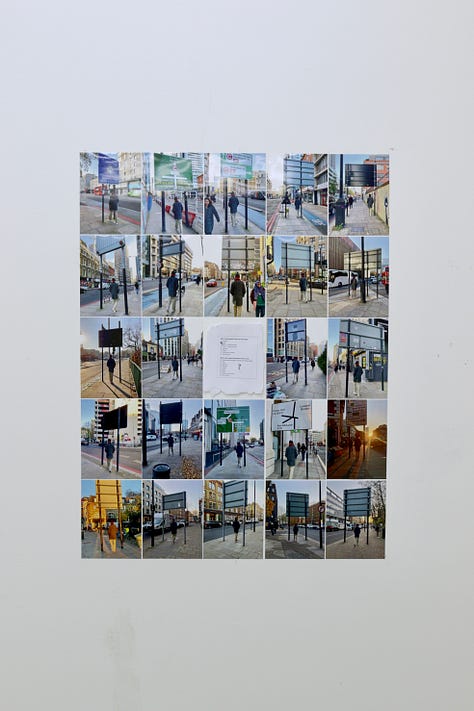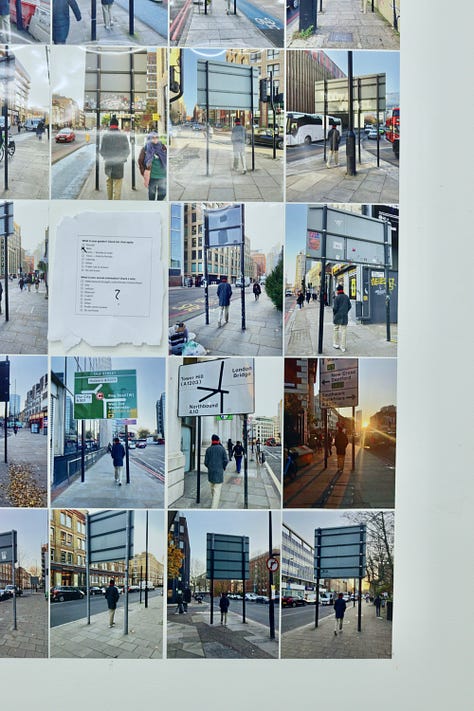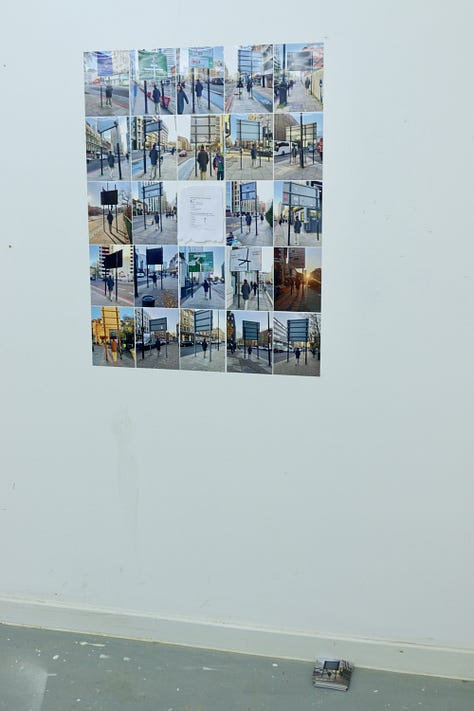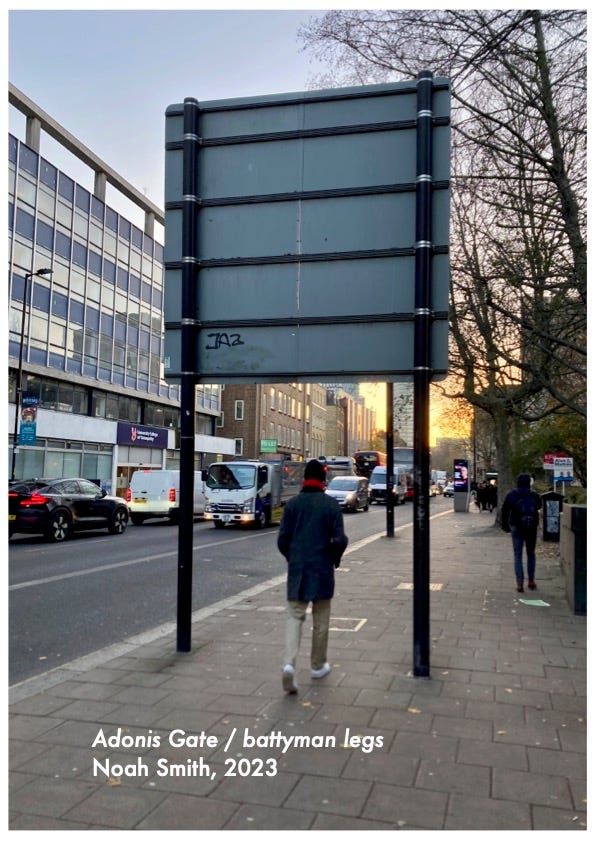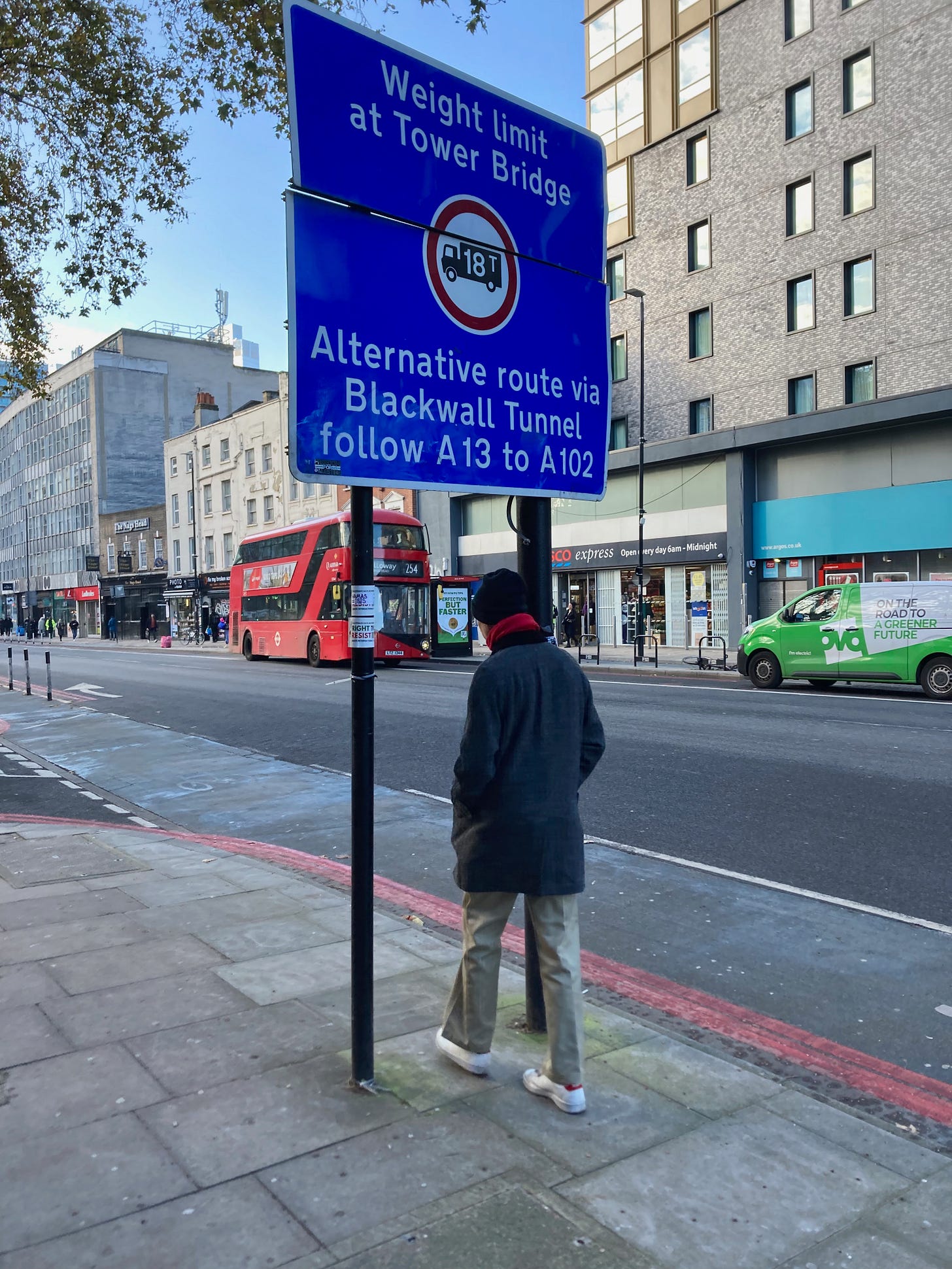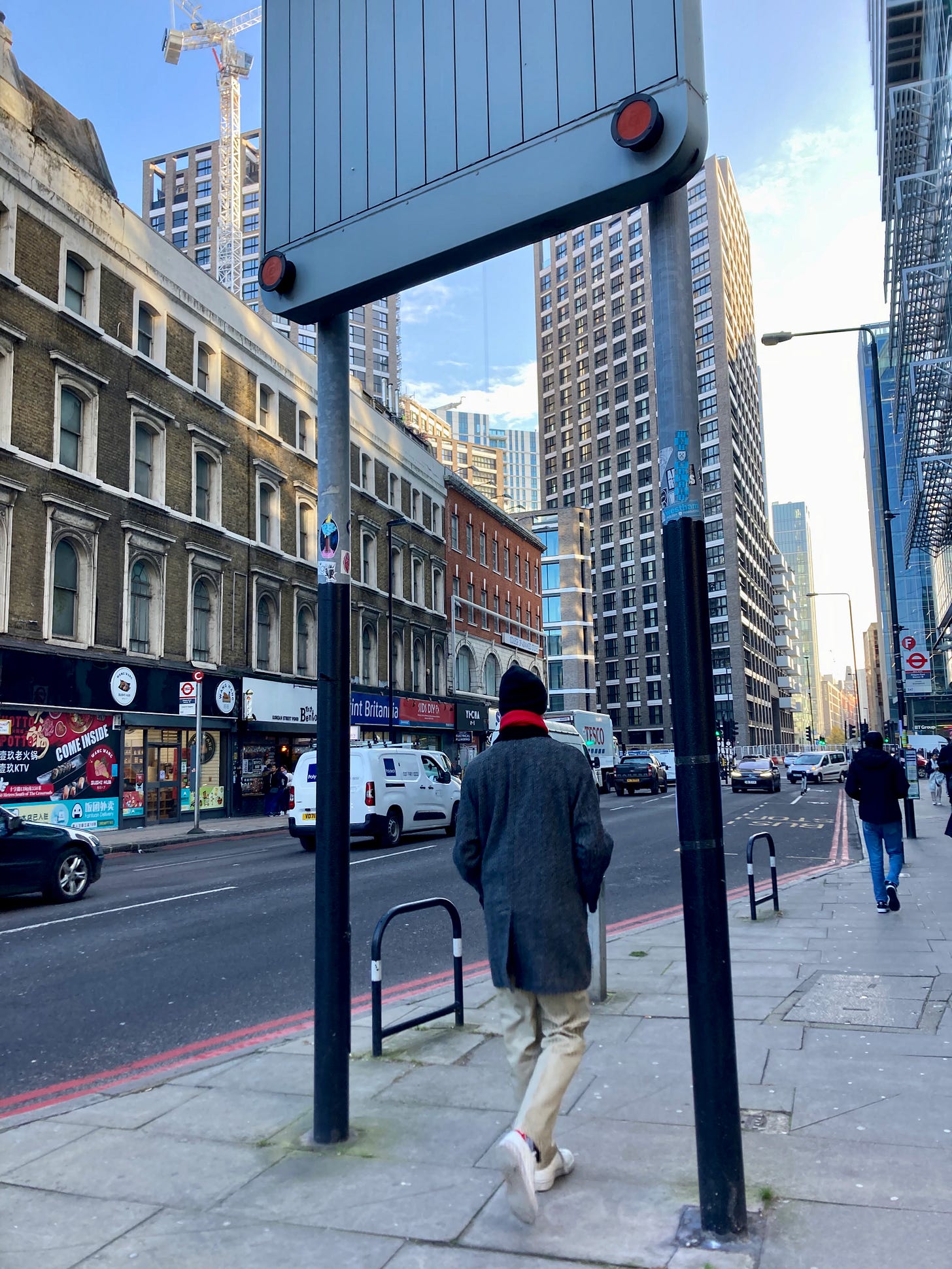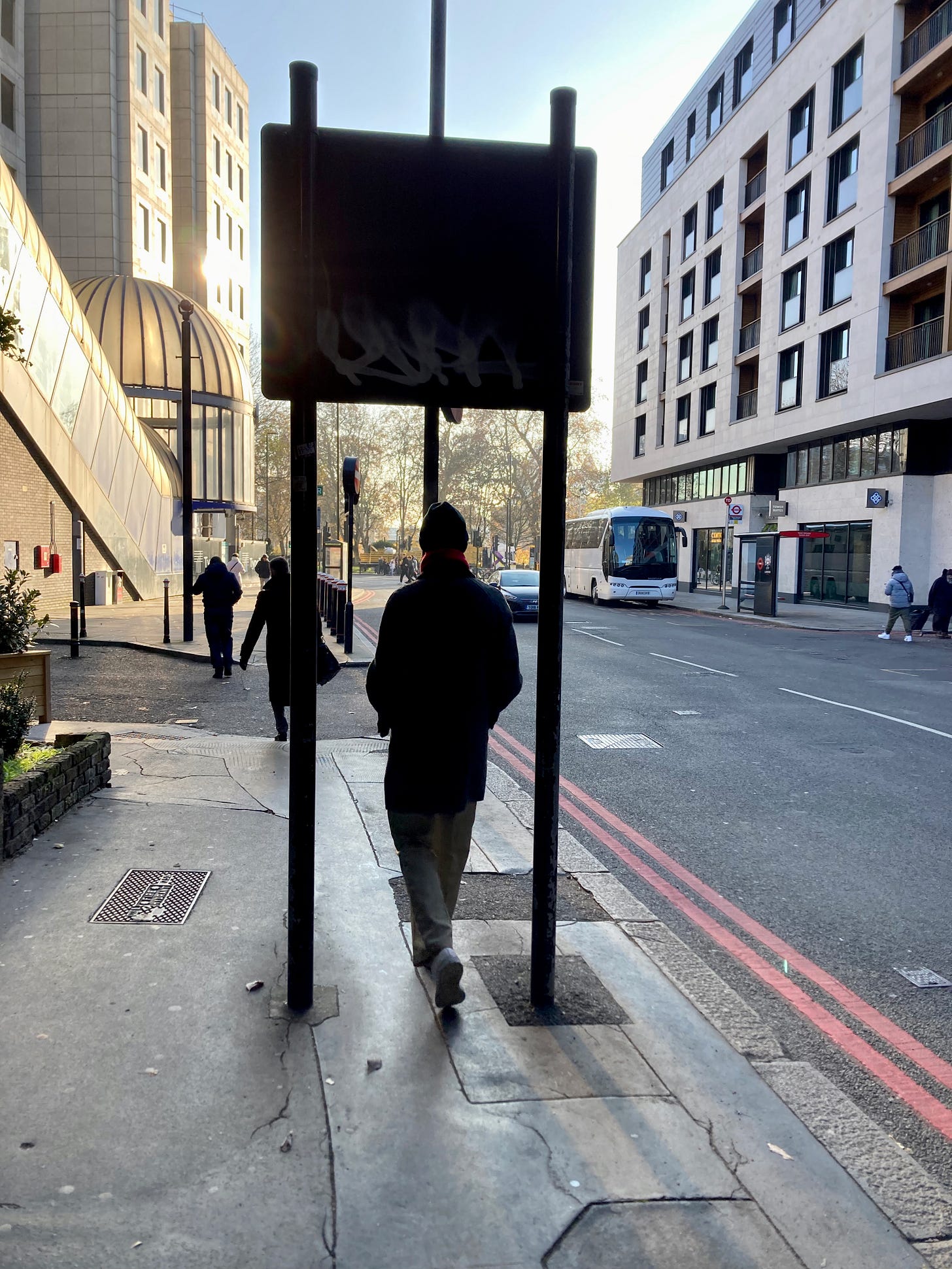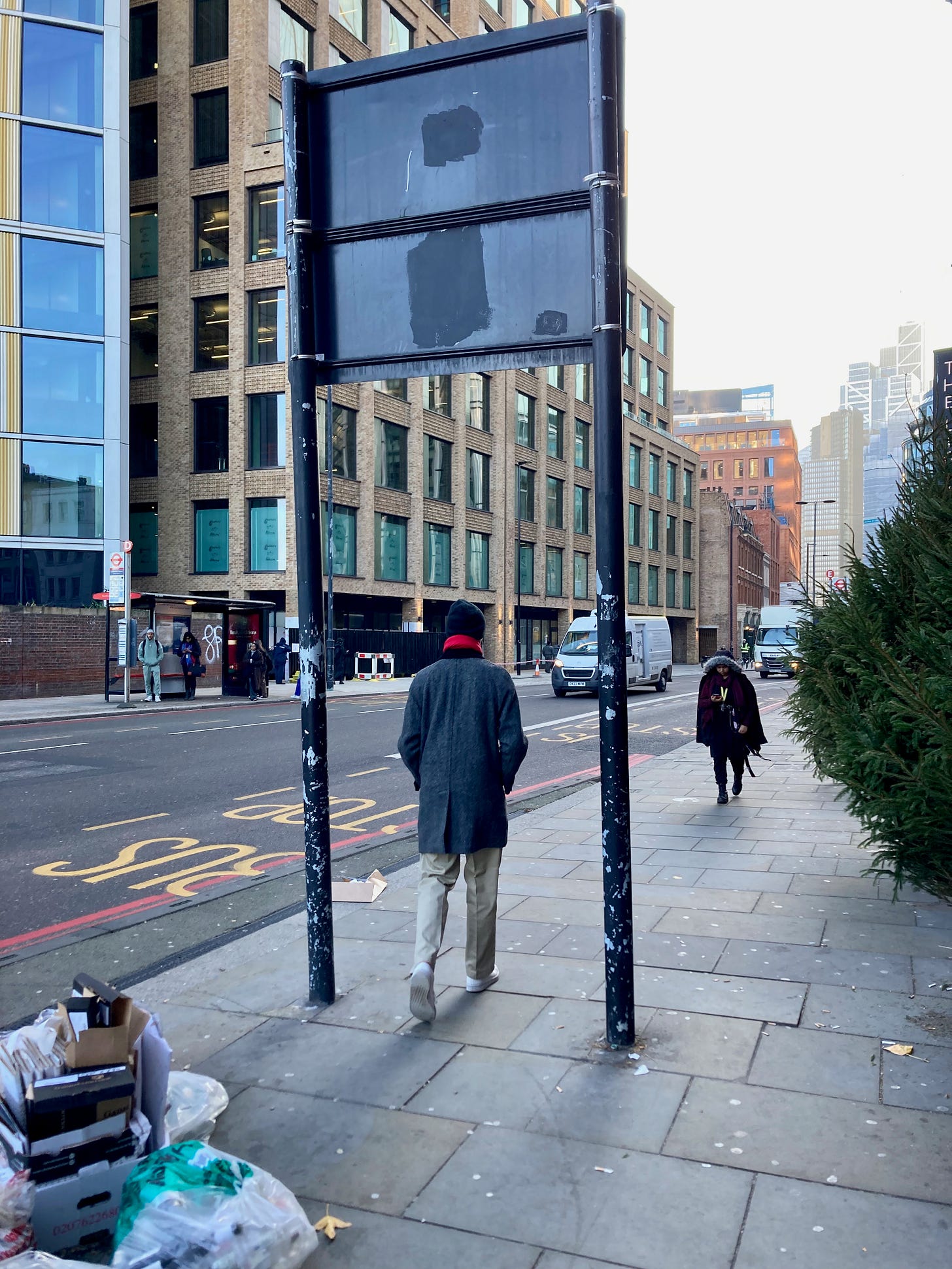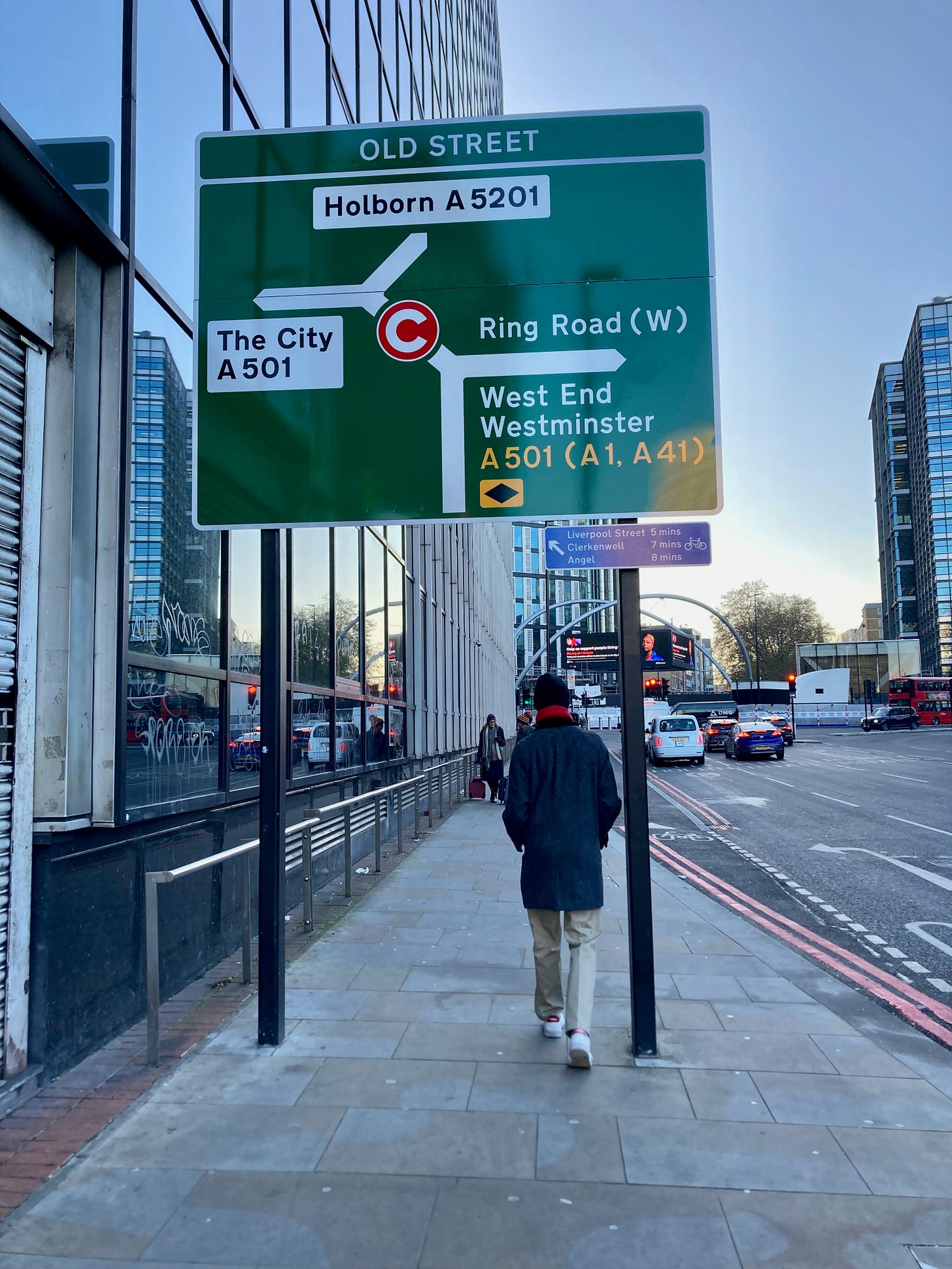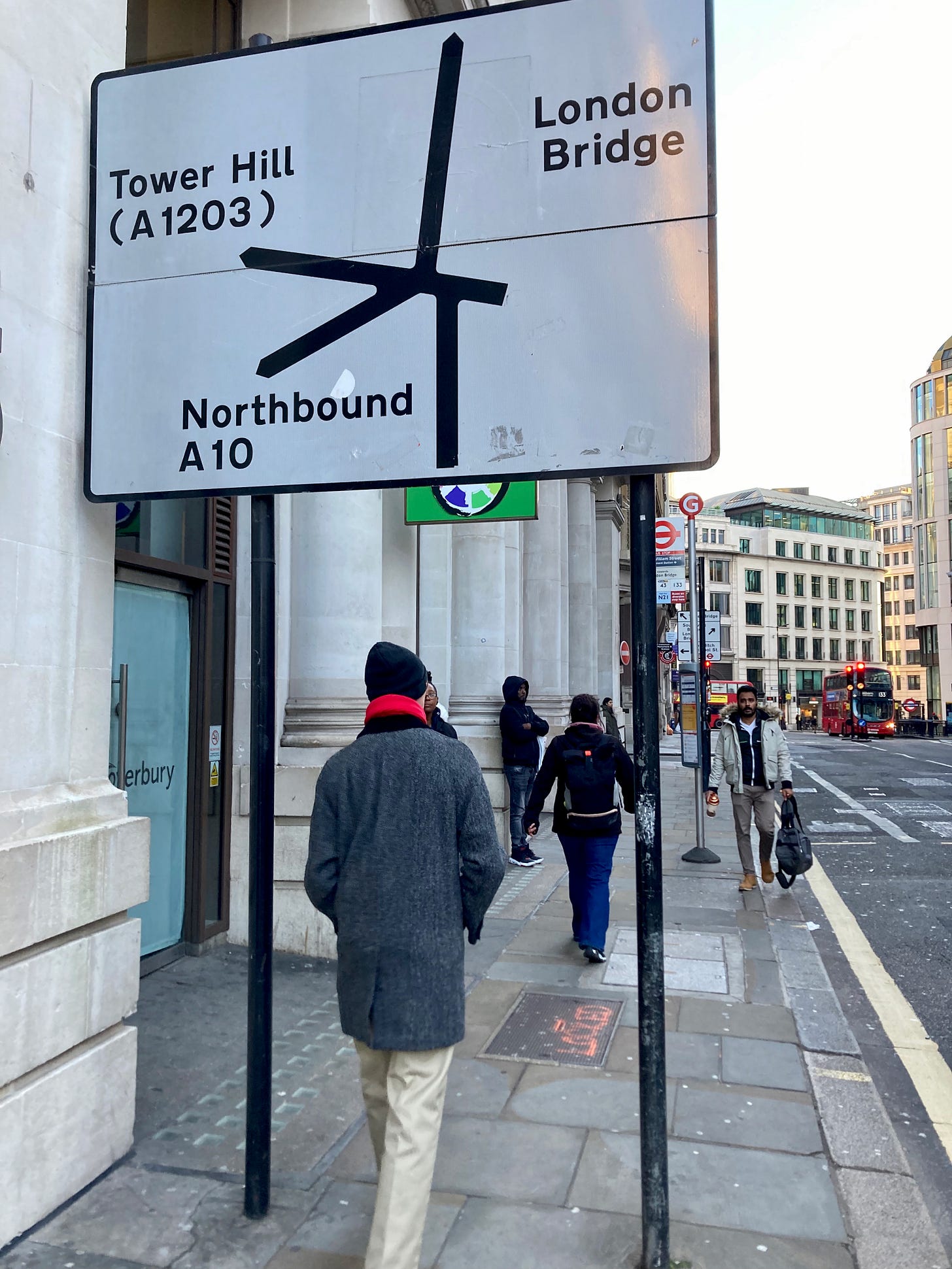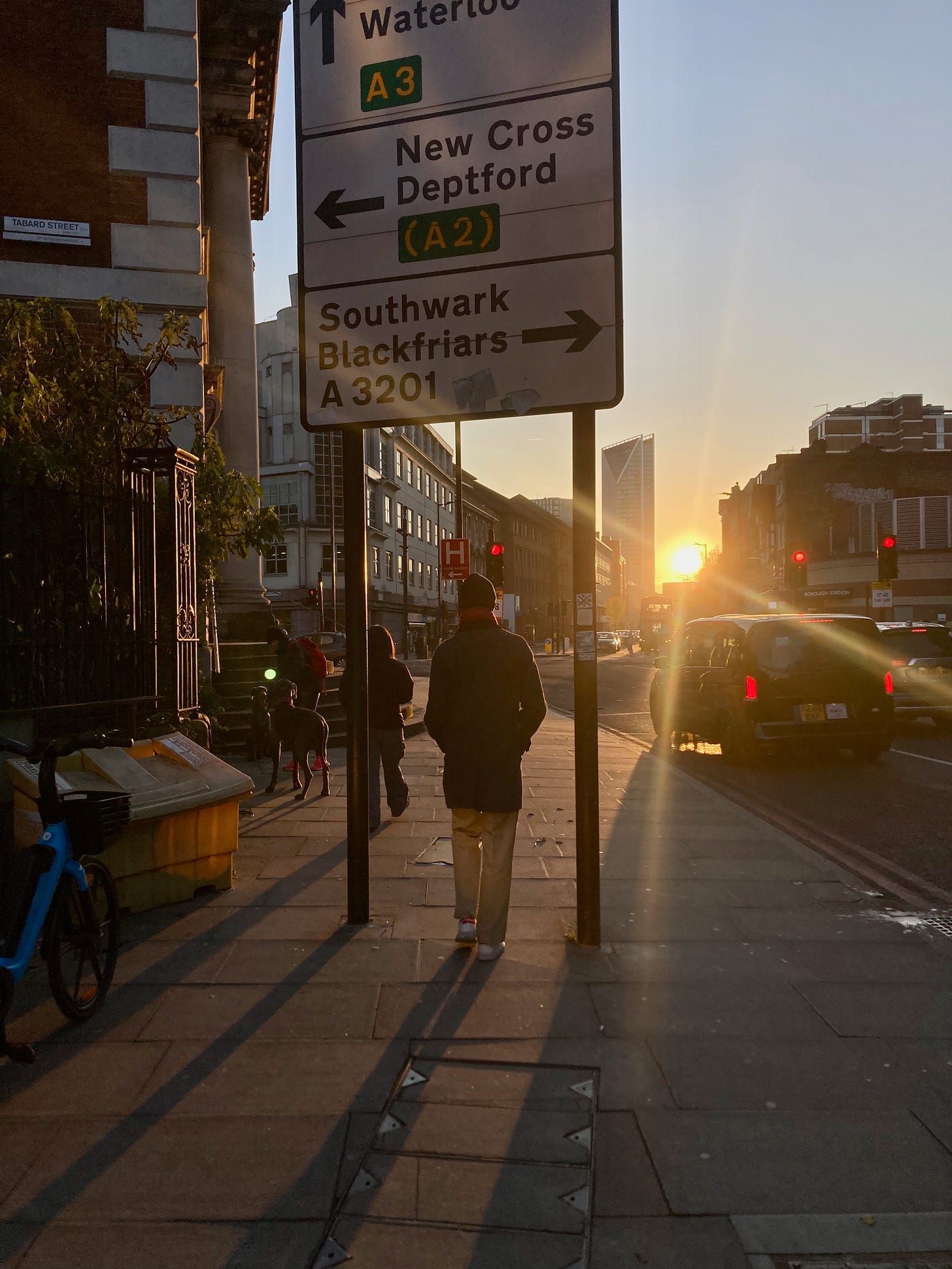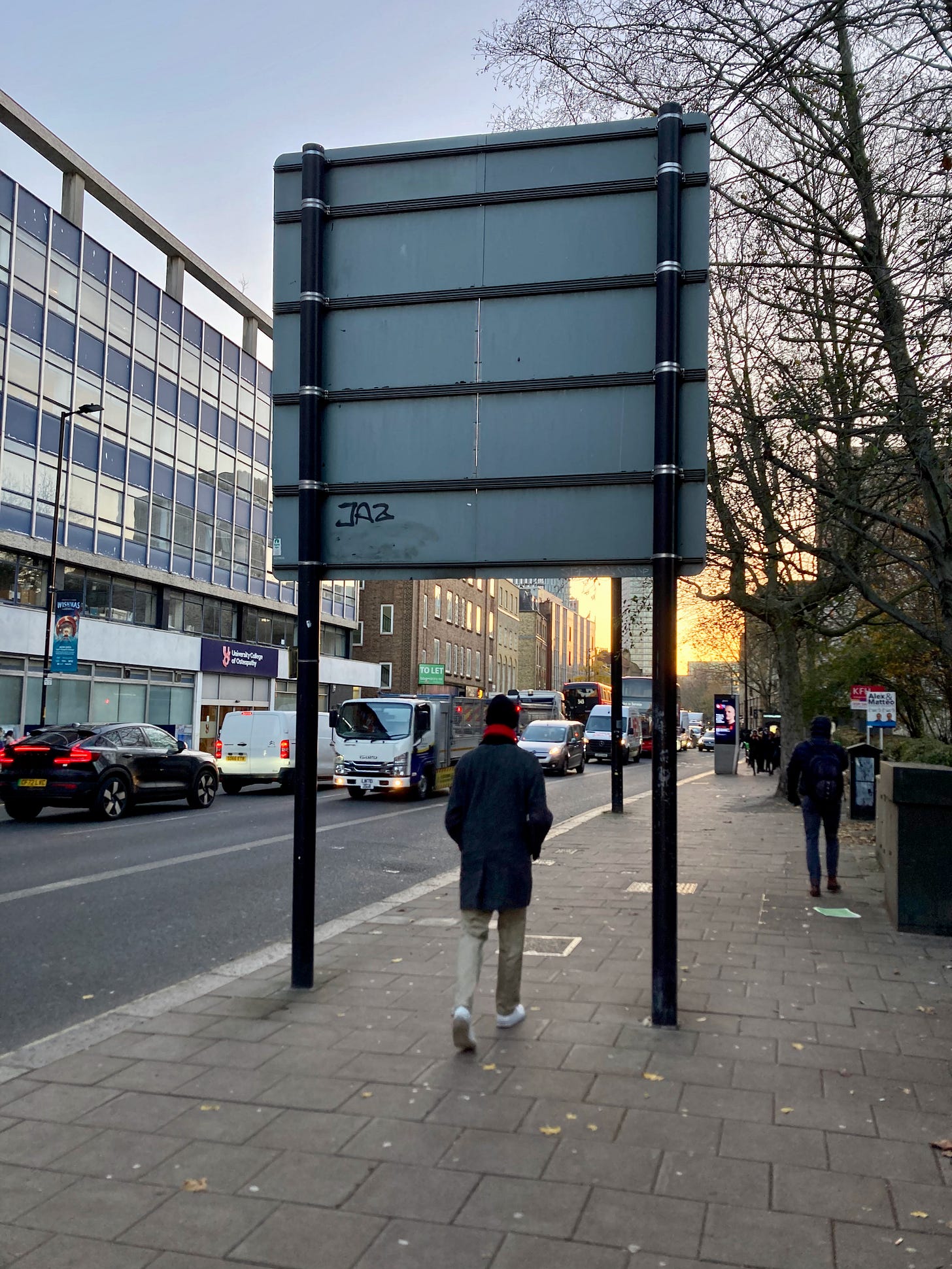This piece of writing has taken much longer to finish than the ritual it accompanies. Of all the avenues and alleyways I could have gone down in this piece, I hope I have explored all the right ones.
“I think I could turn and live with animals. They are so placid and self-contained. They do not lie awake in the dark and weep for their sins. They do not make me sick discussing their duty to God. Not one of them kneels to another or to his own kind that lived thousands of years ago. Not one of them is respectable or unhappy, all over the earth.” Lord Summerisle in The Wicker Man (1973)
I’m looking at a postcard: there’s a person captured in the moment of passing under/through a road sign from its reverse. The location is arbiter, the action is the territory, the motion is the direction. Elsie took the photo on their iPhone (from which I had to convert every image file into a format I could use). We had met in Whitechapel. That decision had been left to fate. Elsie worked in the gallery there and I was from East London. Though this East represented a shift, it was the wrong side of the river Lea, the flat expanse that ran towards the City. This was the East of my teenage exploration, Brick Lane excitement, bagels, anxiety and a fearful lack of transgression; a place where actions would finally have consequences. Both my mother and father had been ill in the Royal London hospital, both with their own specific timings and unchangeable consequences. This felt like a place where I had to rectify a life of mistakes, a life of unaccounted decisions for my own good. It was also a place with arterial roads that would inevitably have road signs.
I had lured Elsie as my photographer with the promise of making art and walking around, both of which were true. I had only alluded to the idea which was unsure of its simplicity and silliness. Upon further prompting, upon my arrival, I told Elsie the formal definition - the urban dictionary definition - of batty man’s legs: that walking under road signs - the ones with two legs - makes you gay. That’s what this was: a ritualised coming out. To myself, to the city, to those that will view the final artwork in its photo form.
The aim is to walk, drift, through London somewhat haphazardly in search of road signs and take photos at each one. We were to talk, aimlessly, to explore, to prod at the city with the hope of making something out of it. Elsie was excited for the journey that was to be almost a mindfulness activity with a friend, the thinking was to be kept at a minimum. Elsie also proved to be one of my spirit guides. What Elsie has shown me is the ordinariness of the non-binary, a very English counterpoint to the hyper-sexualised nature of some of the LGTBQ+ community. There is freedom in being your authentic sexual being but there is also freedom in being a person separate from that totally, that Elsie are just a person before their gender or sexuality. They represent the freedom to be yourself without any high drama, that change and not knowing is a norm.
This feels counterintuitive to say, seeing that we're embarking on a grand ritual to express my sexual opening. I like to be dramatic as much as I need the calm of ordinariness. This is not a binary choice between the two. So we walked. The plan was to stick to main roads as they are more likely to have the signs we needed to photograph. The plan was loose, we didn’t know where the signs were and we were to wander until we found them. The arterial roads were likely to provide the goods, channelling people into and out of the city, to spin them around its fine edges, to keep the cars and traffic in specific areas. To control movement the signs give only so much information.
The walk begins with one step. A beginning of a future by passing through the first sign. There is no binary here, no one-and-done. This is a passage from one place to another, it is open-ended and we can carry on through to pass under another sign, and another, and another, and so on. Hacking at the truth through thousand tiny cuts, a torture for not knowing. I cannot now undo the action, as to pass under the same sign back the other way is still to pass through it. By trying to reverse the journey I end up further along my path even if I end up in the same physical space. Yet the walk, the journey we are to go on is relying on a movement through physical space as well as mental space, so we must continue on.
I remember, with great pain, the teenage stupidity of school. The inability to fit in, the lack of friends, desperately obeying nonsensical rules in order to become part of some pack to not feel like an outlier. I remember Tom. Unwavering in his self-assuredness as the only out gay kid in the year. I remember the hatred placed upon him. I remember seeing a panic attack for the first time - or at least what I could directly understand to be one. I remember the most virulent hate-fuelled boys coming out as soon as the false structure of school dissolved in the summer light. I felt those bullies healing as they told their truth. I could feel the pain of both sides. Yet still I held my tongue for I could find no binary truth.
Jack has been my guiding light, my oldest friend, I am to be his second best person at his wedding, as his future husband will be his best man. I remember meeting him as we began two final years of schooling together. Fresh pastures for both of us. The hope of greener, calmer meadows where we could run free. He was recently out and I felt assured in his self-assuredness. But we were walking into owned territory, we were already outsiders before we had started and the lifers at the school could smell blood. I remember one of the boys shouting faggot out of a window at us as we passed. I remember my blood boiling. The teenage rage rising, steam billowing into a sealed container ready to blow. I remember standing there, shaking with nervous energy unable to move. I remember thinking of running in there and laying down punches on the first person I saw. I regret not doing it.
A deliberate act of movement, a transgression against a rule to prove the rule. To be empowered by it too. The lore of teenage boys, a ruling of boundaries to see who will cross them. The idea is stupid that walking through something could change something fundamental about you like that. Yet there is a symbolism that draws me back, something ritualistic. There is the visual likeness to a Stonehenge trilith. A passing through to undo a stupid past, to become my true self, to come closer to an ancient past, to die, to be reborn.
My face rests on a monumental stone. The heat seeps into my face, the stone warmed by the midsummer sun. We embrace, it feels maternal, it feels old, it is coming home to the ghosts. The drum circles beat out a rhythm that works its way through me. The crowd throngs between the stones ready to lose themselves into the briefest night before the midsummer dawn. The death and rebirth of light, of self. History is a guarded practice, those only in the know can know. This neolithic monument predates written history so any explanation is more vague, less definite, so I take solace in what I can feel now, that we are not the first people to take on this transformation together. The now draws me back through the layers. Christopher Wren’s name graffitied on to one of the stones. The weight of singular powerful men lays itself on us again. The hulking mass of St. Paul's cathedral, the church and it’s repurposing of ancient monuments, its distaste for homosexuality, wresting power from the people by threatening their souls with hell. Boys and their silly little rules.
Our initial progress was good, finding a plethora of signs not far from our starting point diving towards the city centre. We head through Aldgate then down towards the river. The signs are ticked off as we emerge under a railway bridge back into the long December sun. The sharpness of the light brings a certain clarity to the view of the White Tower and the river. The cycles of time emanate out from the Tower like shockwaves, with it as the epicentre, and further constructions and fortifications each another layer of time. The docks, Tower Bridge, old Billingsgate Market, Cable Street, the DLR, even the Cycleway. We stand on the precipice of the Romans’ London Wall, another circular fortification, another echo of the cycles of time coming back round on us. The roads we are to follow are not so subtly dictated by ancient decisions; the vehicular arteries don’t cross into the square mile.
The strict edict of this ritual forces our journey, on foot, to be dictated by cars. The inherent urbanism of this venture is interwoven with the motor vehicle. In a way, it is doubly necessary to complete this venture on foot, by undoing the curse of the teenage boy, by becoming the pariah, to enact my personal sexual freedom while freeing myself from the physical cage of the car seems apt. The car: a shell presented as the freedom machine. To buy, to burn fuel, to spend money, to take on great distances separated from the outside world, to be contained in a metal box, a perfect capitalist consumer. To be driven from a sense of place, a sense of personhood, to be separate from an outdoors presented as dangerous. Humans in boxes, tessellated on roads, direction space and movement predetermined, paying to leave and to return, yet this is presented as easier. This journey is about shedding what other people believe is easier, or correct, it is to move outside the box; to follow my own desire line directly where the car cannot possibly go.
The Ballardian nightmare vision of car culture in Crash seems more real than ever. The formalised violence and drudgery of London juts into the overt sexuality of the place as well. The rush to cross the road edging us to a violent union; the overpasses and seedy corners created by the confluence of major transport constructions are dark spaces for the exchange of sexual favours - a happy contrast to the lush greenery of Hampstead Heath. Ballard can seem to go too far, his characters' search for sexual freedom oversteps into violence almost instantly, all the while being chased by an imminent threat of death. The two come hand in hand in a most British tradition that we cannot be our true sexual selves until our lives are on the line. The lovers in the bombed-out buildings of the Blitz. The rage and death of the motor vehicle, its protective cocoon is our secret personal space, the implicit sensuality of the knobs, wheels and leather interiors. They allow us to live in the moment just before the crash with the belief that nothing can hurt us, and for this we praise them and let them rule our cities.
Yet this ritual walk cannot exist without the car. The mental balance of narratives gets harder to hold, the gymnastics of it all becomes more complicated with every step I take. What do I say? I think about my Dad. The unfortunate timing of it all. Dad, 20th century apostle, phoenix raised from the ash of the post war docks, rat-running car devotee. Just as I was about to experience my own crash, a sudden climatic release of one self into the other, a finite moment, a date to remember and revere, it was aborted. Dad’s decline reached a precipice just as I gained a true knowledge of myself. The Ballardian tightrope between sex and death was flattened, from the sharpness of a novel, into the extended dullness of reality. The last months came in the heat death of autumn. The fiery passions cooling with the body temperature. The decisions of what to call myself got lost under the decisions of what last things to say before the decay of understanding got too far. There was no freedom under the rot and no escape in the loss.
The true heartfelt words never survived the tightness of Dad’s throat, closed tight by the stiff lip and inward pressure to be a man. The meaning implied in his brief words of encouragement, the subtle looks and a hand on my back was something to be learned through time. I understood his care, as much as he was able to give, but there was no assuredness in the implied. We had to believe in the motive behind his actions. We were denied a confirmation in his voice. In a final becoming of man, of following tradition, I denied him a definite knowledge of my true self. Maybe he already knew. I have no doubts he would only have been supportive of my life and proud that I choose to do things my way. I’m sad I didn’t tell him, when time is precious there is only so much you can say.
The truth, as much as truth can ever be such, is that the conversation would never reach a full understanding, how can you speak with someone who never uses their voice? Questioning my sexuality inevitably leads to questioning my gender. Compared to the hours spent walking with Elsie this writing process has crossed epochs and with it the coming out changes. The thoughts develop with time, the ritual representing further clarity than I had during the walk. Such magick is a powerful force. My disjointed relationship with masculinity can now be more effectively expressed as dysphoria. Wrong peg, wrong hole. The conversations would deflate for lack of intense self-reflection on his part. I have never been able to live without questioning everything about myself. So what I thought was a final becoming of manhood, the supposed final understanding of self, was a completion of standing the dominoes. How they fall.
The journey at this point had reached a doldrums of appropriate road signs. Like the best adventure stories we journeyed onwards with great distances covered in a few words. Nits on the barren scalp between thinning hairs. The buildings are getting taller, the streets more cavernous, yet they have never felt more barren and inhuman. The capital succumbs to capital. The bustling streets docked off to be replaced with displays of maximalist dominance. Yet the glass buildings that constitute these displays are fragile and hollow as glasshouses; no one here throws stones. No one ever questions why. The very act would sag the steel beams, liquify the foundations. Introspection as total collapse.
The traces of masculinity in the city's architecture haunt me as they loom above. I’ve always wanted to know the city as well as my dad did, all of its streets and cut throughs. To become this master of the city is secretly a masculine goal; it is to become dominator, overseer, all knowing, to control it. Or is this need for control my way of overcoming masculinity in its architectural physicality? A way of coming to terms with my masculine patrilineage by repurposing it as my own queer self-discovery. All this stone, concrete, steel and glass is a cover for never really knowing, never questioning what it means to be a man, whether any of us were even meant to be one, it is a facade above all else. Once I understand the geography I've won. I am above it. Build all you like but the streets are mine.
In passing, Dad's life has become serialised into a mythology of fragmented memory, all stitched together with what we can recreate of the human. But I need a reality I can feel, I hope the physicality and geography of the city can guide me to my own knowledge. So I stitch it together, to Dad, to my lineage, to the city. To grant myself the backing of place, to grant myself the energy to call myself “human” and be strong enough to believe my true feeling of what that is for me. To face the city's streets with confidence is to face my dad with confidence; that I am who I am, whatever that may be.
Elsie and I reach Bunhill Fields Burial Ground. Final home of the outcasts. We had just completed a bountiful circumnavigation of the newly redesigned Old Street not-roundabout. The open wounds of construction trenches displaying the sickly roots of the signs in the old London earth, the water of the hidden rivers, electricity and internet cables running past basements carved out of Roman pottery fragments. Through the melee we had passed under many signs, before heading south and stumbling on Bunhill Fields. The outcasts’ fen, dumping ground for bones, the bone hill so called as the ground was raised up by excess Saxon bones and plague victims before becoming resting place to religious non-conformists. John Bunyan, Daniel Defoe and William Blake. The pilgrim, the lost adventurer and the visionary mystic. A lineage that seems significant to this ritual journey of life, magick and mysticism. It is a male lineage of outcasts though. Their gender reliably keeping their histories alive, outcasts enough for the church but male enough to be tolerated later. The women here are but wives to great men, robbed of their own story. The remains, physical and spiritual, of those that were not contained in the binary are lost. To be forgotten requires someone to have remembered you once.
These men sought a mysticism through the religion that was designed to pacify and obscure it. London: the forest of spires; stone fingers pointing to God. While churches echo ancient monoliths, they are only interested in mimicry and repurposing of ancient belief structures; detach humans from the outside world and cocoon them in dogma. The rigid structure of Christianity is the antithesis to the circular year, to the connection of Humans to Earth. The solstice sun rising over the heel stone at Stonehenge burns green patches into my vision. The crowd assembles every year for this moment. Humans erected the stones but natural forces power them. It is a symbiotic connection: the people, the ground, the stones, the sun, the stars, the embers of the fires that keep us warm mix with the ancient cremation ashes. The city’s concrete detaches me from the ground, the buildings obscure the sky and the lie of the land, until the Earth is only there by memory. So we become necromancers: reanimating the dead streets, the dead road signs, each passage I make brings them to life, albeit briefly. An instant gestation of a new self. The men and schoolboys fear life as much as they do death.
Resurrecting the dead is no longer new to me. Back east of the city, I am fording the dirty river Lea, a hidden stream of sickness, histories carried like sediment to be deposited and washed away at its will. Hackney Wick, an island in the stream, a contained Albion separated from the land by a tidal wave: the heat of investment thawing the ice age trading estates once frozen in time. The shaggy leftovers of east end sabre tooth tigers and mammoths were cleaned up and moved on before they got a chance to rot. What's left are empty warehouses ripe for tenuous living arrangements and tumbledown clubs. This is the necromancer’s play place, detached from what it was, the space is open to those who can reimagine what life is. Those that slip through the cracks in the city end up on the hidden islands, so it's in spaces like this that the queers organise parties free of gender and commercial interest, where sexuality is fluid like the water. It is here I am wetted, a baptism in the river Lea, a pennant's toll for cruising into London proper.
Yet baptism implies a need to be cleansed of a sin I don’t abide by. What if I were to reject the cleaning forces of baptism and be carried with the river instead, to ride on the wave that carved the island free? Islands, circles, passing, cyclical notions of time imprinted on places, rebirth from death, to pass away only to recreate yourself. Partners of partners, kisses and the possibility of a multitude of love and sexual freedom. The soft plastic body. Wallace-and-Gromit English sensibility with the soft plasticine ability to mould myself into new shapes. There are no binaries and it is easing my knowledge away from what I am to what I will be.
Yet here, in the city proper, the plastic nature of love I crave is so distant. The developers are scraping the plaque off the city; I'm but a microbe in the gnashing jaws, taken from the home I feed on. I begin to feel spent. We fall south through Moorgate slowly picking up more signs. I was aiming to get enough photos for a 5x5 grid, so we pushed on to complete the aesthetic goal of 25 signs in total. It's more than you think. We're drawn towards Bank in our daze. The light fading rapidly. The heart of the city sucking us in only to pump us back out again. And so we are spat out on to London Bridge. There is a weary inevitability to our final direction.
London Bridge is by no means what it was. The 70s concreted the coffin lid shut. The Thames washed the ghosts away. The bridge passes idly beneath our feet as we admire the view. No longer suffocated by the buildings we are afforded a distance to take in some of the magnitude of the city around us, steel, concrete, flesh, stories. To the once lawless lands south of the river. Theatres, bear baiting, brothels. We could head East towards the land of my father. But we are bound to follow the path of least resistance. We walk the road towards Elephant and Castle.
There's a web of connections on which I'm caught like a bug. Mystic forces awakened by prodding at the city with this magic; energies arcing from crossed ley lines of cryptic geometry. I'm being pulled apart by horses; different parts of my body turning up on street corners in the night, unattached. Bodies buried under crossroads. Vampires. Mysterious people passing through the city at night dressed in fantastical robes. They are the trees, propping bars, they are stars, they are beaten to a pulp but no wooden dagger in their hearts. A shiver runs down my spine, pulling my coat tight against the winter cold, I finally understand my place in the lineage of hurt and love. The rain clouds are finally clearing and like gods we must continue to wave them away.
The sun dips ever closer to the horizon. The exhaustion building at the end of the ritual, a day in the weak sun, like a tea bag dipped in a hundred mugs of tepid water. Transformations take so much of us, and I have given everything. The city demanding a sacrifice. I'm shedding layers of self under every sign. Peeled. Shredded. The desperate slow motion sprint towards the finish line, like a dream, like running in honey.
There's a flurry of photos taken around a bountiful junction with a forest of signs. The excitement builds one last time before the finish. Every passage is as meaningful as the first. Joy overcomes. Then it is complete. The passages are done. We look at the final photo on Elsie's phone. Something akin to the exhausted breaths after making love. Taking it all in. Coming back to yourself. Grounding on the small realties.
We find a pub that doesn't do chips. I guess you can't have everything. That what you may understand as essential is not so to someone else. The signs are just signs after all. Sex is just sex, love is just love, chips - to some people - are just chips. The meanings they hold to me exist only in my head. The passages are just movements. Monuments only exist for the stories we place upon them. Mythology is a lie to pass the time, to have fun. The city is just a backdrop to play out my introspection. The concrete can't laugh. The bricks aren't looking at me. It's all a ruse to understand. Suddenly, it's all just a memory.
Then I’m there again, at Stonehenge. Another summer gone, another beginning. My body made honest by the stones; their continuity demanding my truth, not all secrets can be taken to the grave. I walk around them in imagined silence in the throng of the solstice celebrations. I walk under/through the remaining triliths like I did with the signs, energies calling to each other through memory, I am a conduit. This place of renewal, of death and burial, a message that life continues on. This yearly pilgrimage is a reminder that my story is written in the city, that London is where I can fill in the gaps between the buildings with my own plastic story.
Structure and chaos, the wild shifts between them, humanity manifest. The chaos of humans crammed into the structure of cars. Patriarchal structure attempting to reign in the true chaos of the Human form. The sign as gateway from one form to another. The homogenised structure of sex, gender and love is meaningless to me so I have to admit I am given in to the glorious chaos as if it wasn’t already part of what makes us human. I admit I love, I admit I am human, I admit I am made of flesh, I admit I am not the structure I am chaos. I won’t stand here for thousands of years. I will dance and jump and fuck and be many, many people. I will walk. I will not fall for any rules of where I may walk. I will gladly take on any transformation becoming and changing what it means to be me. To live fully is to be in flux. There is no binary truth.
